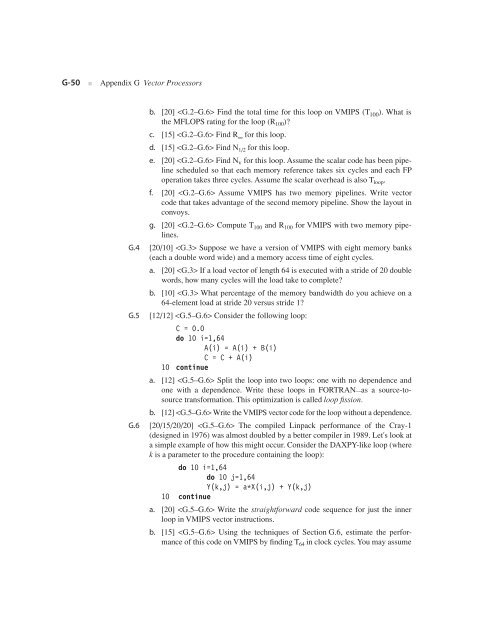Appendix G - Clemson University
Appendix G - Clemson University
Appendix G - Clemson University
Create successful ePaper yourself
Turn your PDF publications into a flip-book with our unique Google optimized e-Paper software.
G-50 ■ <strong>Appendix</strong> G Vector Processors<br />
b. [20] Find the total time for this loop on VMIPS (T100 ). What is<br />
the MFLOPS rating for the loop (R100)? c. [15] Find R∞ for this loop.<br />
d. [15] Find N1/2 for this loop.<br />
e. [20] Find Nv for this loop. Assume the scalar code has been pipeline<br />
scheduled so that each memory reference takes six cycles and each FP<br />
operation takes three cycles. Assume the scalar overhead is also Tloop. f. [20] Assume VMIPS has two memory pipelines. Write vector<br />
code that takes advantage of the second memory pipeline. Show the layout in<br />
convoys.<br />
g. [20] Compute T100 and R100 for VMIPS with two memory pipelines.<br />
G.4 [20/10] Suppose we have a version of VMIPS with eight memory banks<br />
(each a double word wide) and a memory access time of eight cycles.<br />
a. [20] If a load vector of length 64 is executed with a stride of 20 double<br />
words, how many cycles will the load take to complete?<br />
b. [10] What percentage of the memory bandwidth do you achieve on a<br />
64-element load at stride 20 versus stride 1?<br />
G.5 [12/12] Consider the following loop:<br />
C = 0.0<br />
do 10 i=1,64<br />
A(i) = A(i) + B(i)<br />
C = C + A(i)<br />
10 continue<br />
a. [12] Split the loop into two loops: one with no dependence and<br />
one with a dependence. Write these loops in FORTRAN—as a source-tosource<br />
transformation. This optimization is called loop fission.<br />
b. [12] Write the VMIPS vector code for the loop without a dependence.<br />
G.6 [20/15/20/20] The compiled Linpack performance of the Cray-1<br />
(designed in 1976) was almost doubled by a better compiler in 1989. Let's look at<br />
a simple example of how this might occur. Consider the DAXPY-like loop (where<br />
k is a parameter to the procedure containing the loop):<br />
do 10 i=1,64<br />
do 10 j=1,64<br />
Y(k,j) = a*X(i,j) + Y(k,j)<br />
10 continue<br />
a. [20] Write the straightforward code sequence for just the inner<br />
loop in VMIPS vector instructions.<br />
b. [15] Using the techniques of Section G.6, estimate the performance<br />
of this code on VMIPS by finding T64 in clock cycles. You may assume

















